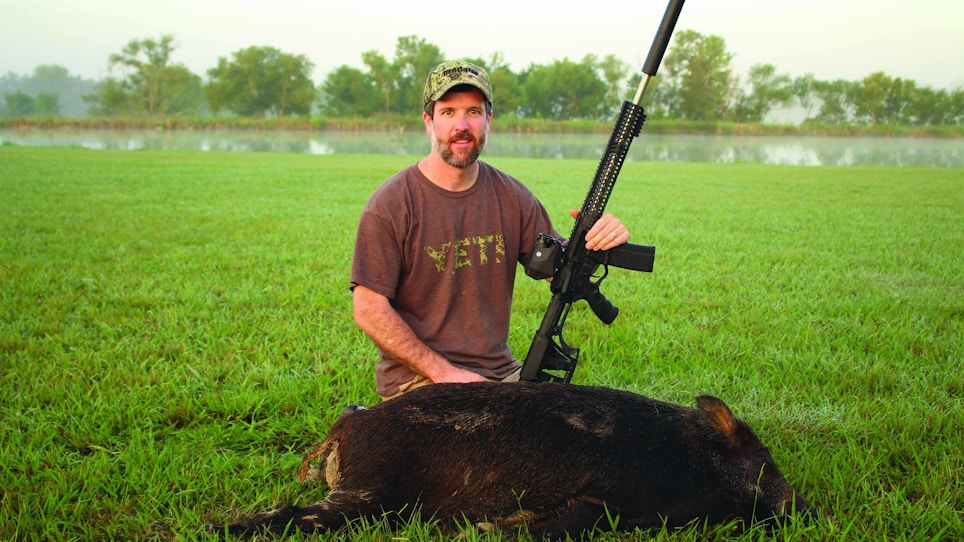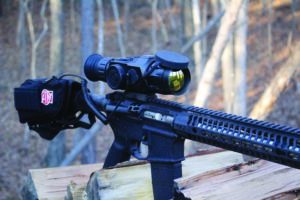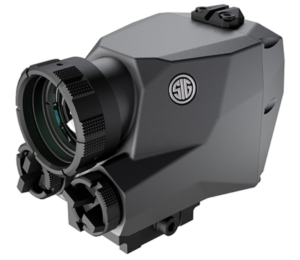Just as we cleared the trees, an expansive peanut field rolls out in front of us. Peering through a night-vision optic I'm using as a spotting scope, I immediately see a dozen or more hogs feeding in the open. I quietly tap my friend and guide, A.J. Niette, on the shoulder and whisper "pigs!"
A.J. slows the electric golf cart to a stop and grabs my optic to take a look. Lowering the high-tech glass, he pulls a wind checker from his pocket and sends a puff of powder into the night air. It gently blows behind us.
“Perfect wind, let’s go,” gruffs A.J. as he pulls an AR-15 chambered in .223 from the back of the golf cart along with a pair of Primos shooting sticks.
I follow A.J. as we march directly towards the group of swine 100 yards away. We carefully step over peanut rows towards our targets. It’s 10 p.m. on a moonless night and the hogs have no idea we’re in the neighborhood. We go about 100 yards and A.J. stops to survey the hogs, which still are feeding about 50 yards in front of us. He sets up the sticks and places the AR topped with another Gen 3 night-vision scope in the cradle of the rest. I settle behind the rifle and peer through the scope into the green-lit night.
The hogs are clear as day in the scope. I can easily see their curly tails swatting back and forth. The bigger boars nudge the other hogs out of their personal space as they devour the farmer’s peanuts. Choosing two 75-pound hogs, I settle the illuminated crosshairs on one’s shoulder and squeeze the trigger. The bullet smacks and the hog drops. I instantly start working over the other hog, this time on the run. As the dust settles, I have two choice pigs down.
By dawn I have 11 hogs on the ground. I was instantly hooked on night vision.
Since that muggy August night in Alabama several years back, I’ve had the opportunity to hunt with and use a number of different night vision and thermal optics. While each platform gives you the ability to use the cover of darkness to your advantage for predators and hogs, each has its own unique features and abilities.
Let’s break down the difference in each so you can decide which is best for you.
Night Vision
Even if you’ve never looked through a night vision optic, you’ve probably seen military video clips on T.V. with the green hued screen. Night vision collects and intensifies ambient light — starlight, moonlight and any other light in the night sky — to allow you to see into the dark. Many night-vision optics are paired with an infrared light to help illuminate a field or target in the pitch black, especially on moonless nights. The infrared light is invisible to the eye, but through a night-vision scope it looks like a spotlight. More expensive night-vision scopes rely less on an infrared illuminator than cheaper units.
Gen. 1, 2 or 3 Night Vision: When looking at night-vision devices you’ll see different ratings for them — Gen 1, 2 or 3. In simple terms, a Gen 1 is going to be a budget-priced scope. Each step up from Gen 1 is going to cost more, but you’re buying more clarity, a crisper image, farther detection with less ambient light available, longer battery life and longer life of the unit itself. Your top-shelf scopes will typically be Gen 3 or high-end Gen 2 models.
Digital Night Vision: The newest classification in night vision. Unlike traditional night vision, which uses an intensifier tube, digital night vision captures light through an objective lens and then processes it with a charged coupler device and then sends an image to an LCD screen. Digital night vision is typically displayed black and white on the LCD screen, unlike the traditional green and black in regular night vision. Digital night vision is typically cheaper than traditional night vision and offers a clear, crisp image. Digital night vision can be used during the daytime, too.
Night vision is an excellent tool for night-hunting predators and hogs without having to shine a visible light into a field. It does have its limitations, though. Depending on the quality of the optic and the power of the infrared light used, you can expect to locate and identify targets out to several hundred yards. However, night vision won’t see through fog, smoke, tall grass and foliage. So, if you scan a field with heavy fog or tall grass, you’ll only see a short distance, much like shining a visible light into a foggy field.
Thermal Optics
Unlike night vision, thermal optics read heat. The high-tech processors in a thermal optic detect the minute and large differences in heat and create a digital picture of the landscape and animal in the optic. Most thermal optics have different color pallets that you can switch between, such as, white-hot or black-hot, etc.
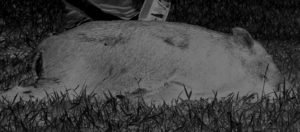
With thermal optics that read heat signatures, animals appear white or gray when seen through the optic. (Photo: Mark Olis)
For example, in white-hot mode hotter objects will appear white and cooler objects will be darker. The hotter the object the brighter the white, the cooler the object, the darker the black. So, if you walk into a field on a cool night and scan with a thermal optic, the grass/ground will appear very dark or black, while a warm-blooded coyote or hog will stand out like a spotlight as it will be bright white against a black background.
One advantage thermal has over night vision is it can see through tall grass, fog, smoke, etc., because it is reading heat and not using light to “see” the image. I experienced the difference in this during a hog hunt is southern Georgia one night. I was using an AR-15 with night vision while the gentleman I was hunting with was using a thermal spotting scope. We were hunting a cut cornfield that had just enough stubble in it that I couldn’t see a large sow feeding 35 to 40 yards in front of us.
However, my hunting partner could see it plain as day in the thermal. He was getting completely frustrated with me for not shooting the pig, while I continued to tell him that I couldn’t even see the pig. The sow finally cleared some of the stubble and I could see it in the beam of my infrared scope and I dropped it with a shot to the shoulder. Warm-blooded animals just can’t hide from thermal unless they are behind a hard barrier or jungle-like cover.
Another advantage to thermal over night vision is the detection range. A thermal can detect warm targets at a much greater distance. A high-end thermal can detect warm-bloodied animals in a field at or beyond 1,000 yards. You might not be able to decipher whether it’s a deer, cow or pig at that distance, but you’ll know if something is there so you can move closer to confirm your target.
However, these advantages come at a price. Most quality thermal optics cost several thousand dollars, whereas you can get into the night vision game for several hundred dollars. Night vision optics can stretch into the thousands as well for top-shelf units. Now that you have a clear understanding in the difference between the two, here are several optics of varying prices and features that I’ve hunted with as well as a new high-powered illuminator.
Night-Hunting Optics
Sightmark Photon Digital Night Vision
I have a lot of time behind the Sightmark Photon digital night vision scope. This is an excellent option to get in the game. You can find one of these for less than $500 and you’ll be scanning and calling at night in no time. It features a built-in infrared light which is great out to about 100 yards. If you want to really light up a field and see and shoot beyond 100 yards, then I recommend buying a quality aftermarket infrared light and mount it to your rifle to extend your effective range.
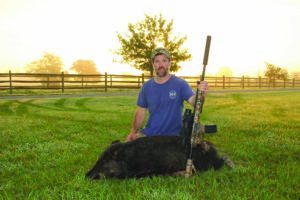
Whether you're hunting with thermal or night vision optics, you're sure to discover new ways to enjoy knocking down feral pigs and predators (where legal) under the cloak of darkness. (Photo: Mark Olis)
The Photon has several things that I like about it other than the exceptional price tag. I like that it runs on two AA batteries. I like that it can be used day or night. I also like that this is a crisp, clear digital night vision optic with user-friendly controls.
This is an ideal optic for night hunting when shooting under 200 yards. It is a fixed-power optic, so choose the one that serves your hunting style the best. I used the 4.6x42 Photon XT because most of my hunting in the Southeast is under 100 yards.
Sightmark launched a new Photon series, the RT version. The RT’s built-in video/sound recording feature is able to send videos and still images to your phone or computer via the Stream Vision App. The Photon RT also features new 2X digital zoom, allowing distant targets to be easily identified. The RT boasts a 3½-hour battery life with IR on from four AA batteries. Other features include six reticle options with four different colors, an extremely useful one-shot zeroing function, power input for external battery packs and a front focus objective lens. Compatible with most aftermarket 30mm rings, the Photon’s additional weaver rail on the side allows users to attach aftermarket IR illuminators and accessories. www.sightmark.com
NiteSite Eagle RTEK
The NiteSite Eagle RTEK is for the hunter who would like to have night-vision capabilities, but not have a designated night-vision only optic mounted on their rifle. The Eagle RTEK consists of a IR module that mounts on top of your existing daytime scope. The IR module features five powerful infrared illuminators and an LCD screen on the back of the module which the hunter uses to view into the dark. A rubber sleeve fits over your scopes ocular and an IR camera then inserts into the rubber sleeve. All of this is wired to a battery pack that mounts on your rifle’s buttstock.
The Eagle RTEK’s IR illuminators allow the hunter to detect predators up to 550 yards away. When you combine this setup with a solid tripod in the field, you can easily scan fields for incoming predators or wild hogs. The best part is, you don’t have to re-zero your daytime rifle scope. Because the IR camera mounts to the back of your scope, it utilizes your scope’s crosshairs, which means that your rifle’s zero remains the same with or without the Eagle RTEK attached. So, you can still call predators in the daytime and then simply add the Eagle RTEK to your setup once night falls. The NiteSite Eagle RTEK sells online for about $1,350. You can also record your hunts through the device. www.nitesite.com
Pulsar APEX Thermal
I’ve hunted with Pulsar’s Apex XD50 thermal optic a number of times for hogs and coyotes. I can say this is a top-notch piece of equipment for hog and coyote eradication. While Pulsar no longer offers the XD series, they now have the new Pulsar Apex XQ38 Thermal Riflescope. This unit provides many of the great features of the XD series, but with a faster processor and better battery life.
The XQ38 provides vivid thermal imaging from a 384x288 core and crisp 640x480 AMOLED display. The XQ38 offers a 2.1X base magnification with 2X, 3X and 4X digital zoom and smooth digital zoom up to 8.4X. Featuring three zeroing distances, 10 preloaded reticles and three different operation modes, the Apex XQ38 can detect heat signatures from up to 1,475 yards away.
It runs on two CR123 batteries which will power the Apex for 4 to 5 hours. The Apex has a plug-in for a rechargeable external power source. Trust me, you’ll want to buy the external battery pack as it will allow you to hunt all night without worry of batteries going dead. Pulsar Apex XQ38’s also includes wireless remote control, video output/power cable, 2xCR123’s, carrying case, cleaning cloth, user manual and warranty card.
One of my favorite features on the Apex thermal is Pulsar’s proprietary picture-in-a-picture (PIP) feature. When using this, a smaller screen appears above the reticle on the main screen. It shows the same picture you’re seeing in the main screen except it zoomed in 2X. This helps tremendously with longer shots or when taking that first shot on the lead pig in a sounder. With the zoomed in reticle option you can ensure you make an accurate head shot, while dropping to the less-zoomed screen below which offers a wider field of view for shooting running hogs. I took three large hogs out of one sounder in Texas with the PIP feature. I’ve been old ever since. The Apex XQ38 sells for $2,750. www.pulsarnv.com
ATN THOR-HD 640 2.5-25X
The ATN THOR-HD 640 is for serious predator and feral hog hunters. The technology included in this optic allows the user to detect warm-blooded critters from 1,500 meters away. You can literally travel from field to field and scan the entire pasture for predators or hogs. Images are crisp and clear in the ATN THOR and the magnification range is from 2½ to 25X.
The THOR HD-640 has a ton of high-tech features built into it. You can program and save different load and ballistic data for each weapon you plan to use it on, measure barometric pressure, apply wind speeds to an onboard ballistic calculator. One piece of technology that I find to be a tremendous help is the built-in range finder. One of the hardest aspects to grasp while looking through thermal or night vision optics is how far away your target is. Remember, you’re literally looking at a screen, so depth of field can be tricky. However, the range finder takes all the guess work out so you can make accurate shots from close range to hundreds of yards away.
Other cool features built into the THORD-HD include recording video through the device. It also has a recoil-activated video option and will record your hunt prior to the shot, during the shot and after the shot, even if you forget to hit the record button. The optic also has Bluetooth and Wi-Fi capabilities. All of this is powered by an obsidian core that allows the optic to do its job while providing you with everything needed for serious predator and hog removal operations. The ATN THOR-HD is a step up into professional-grade thermal imaging. With that comes a bigger price tag; this particular model sells for about $5,000.
If you’re making this kind of investment, then I highly recommend spending an extra $100 on the ATN Power Weapon Kit. The power pack features a battery pouch that mounts to your rifle’s buttstock. A power cord plugs directly into the THOR-HD thermal and the rechargeable battery pack. Thermal units can eat through battery life and you’ll spend a fortune on specialized batteries as well as frequent change outs, which can happen in the middle of a stalk. The small battery pack fits nicely on the weapon and will give you up to 22 continuous hours of runtime for those all-night hunts. www.atncorp.com
SIG ECHO1 Thermal Reflex
SIG Optics released a one-of-a-kind thermal optic last year. The ECHO1 digital thermal reflex sight is a weapon-mounted sight that offers both-eyes-open shooting unlike other thermal optics. You simply mount the ECHO1 to your rifle and utilize it as you would a daytime reflex sight. You can shoulder the weapon, place your cheek on the buttstock and scan a field while looking at the LCD screen on the back of the unit.
I used the ECHO1 on a nighttime hog hunt in Alabama last summer and it performed well. I liked how I could scan the field with the sight but not have to put my eye up to the optic as if it was a traditional thermal or night-vision optic. I was sitting in a shooting house about 30 yards from a corn feeder, so I could quickly and easily scan the field without putting my cheek on the buttstock. When a hog finally arrived, I could easily place one of five digital reticle options on its shoulder and squeeze the trigger. The color screen has a number of different color palletes and user-friendly controls. You can capture photos with the ECHO1 as well, and it’s waterproof.
This sight would be ideal for close-range hunting, such as sitting over a feeder or in smaller pastures. It has electronic zoom from 1X to 2X, but I wouldn’t feel confident making accurate shots on live targets beyond 200 yards. The limited zoom makes identifying your target beyond a couple hundred yards difficult, too.
The thermal sight would aid in game recovery and field scanning even if not mounted to your rifle. While I haven’t used it for this, I believe this would be a great sight for a shotgun on nighttime hogs and predators. The SIG ECHO1 sells for about $1,500. www.sigsauer.com
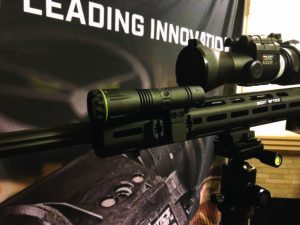
Night Optics FIR-i focusing infrared illuminator is small and lightweight when attached to your favorite rifle. (Photo: Mark Olis)
Night Optics FIR-I Illuminator
As mentioned earlier, a night vision optic works best when paired with a quality infrared illuminator. Night Optics FIR-i illuminator is not only extremely powerful, but also tiny in size. This focusing infrared illuminator is less than 5 inches long and a shade over 1¼ inches in diameter, with an undetectable weight when mounted to a weapon.
The most amazing part of the FIR-i is it rated for illumination beyond 1,000 yards! It will run continuous for one hour on one CR123A battery and hardly takes up any room on a Picatinny rail. It also MSRPs for $299. Check out the FIR-i and all of the other night vision and thermal optics from Night Optics at www.nightoptics.com.
